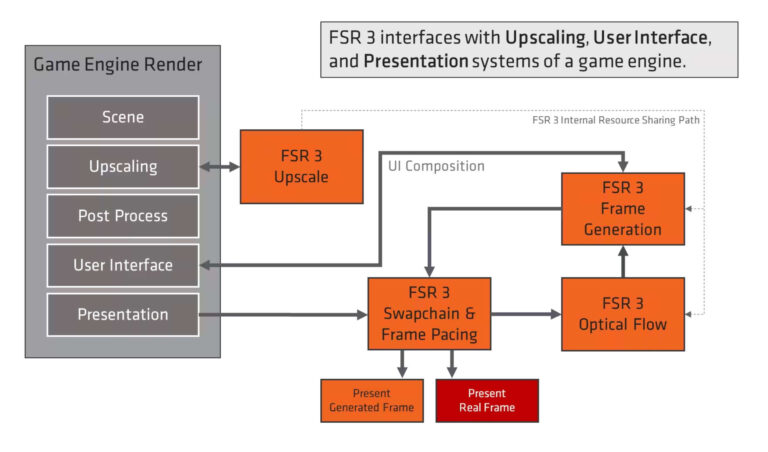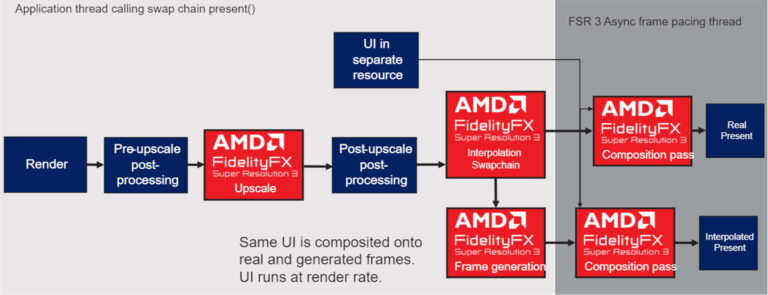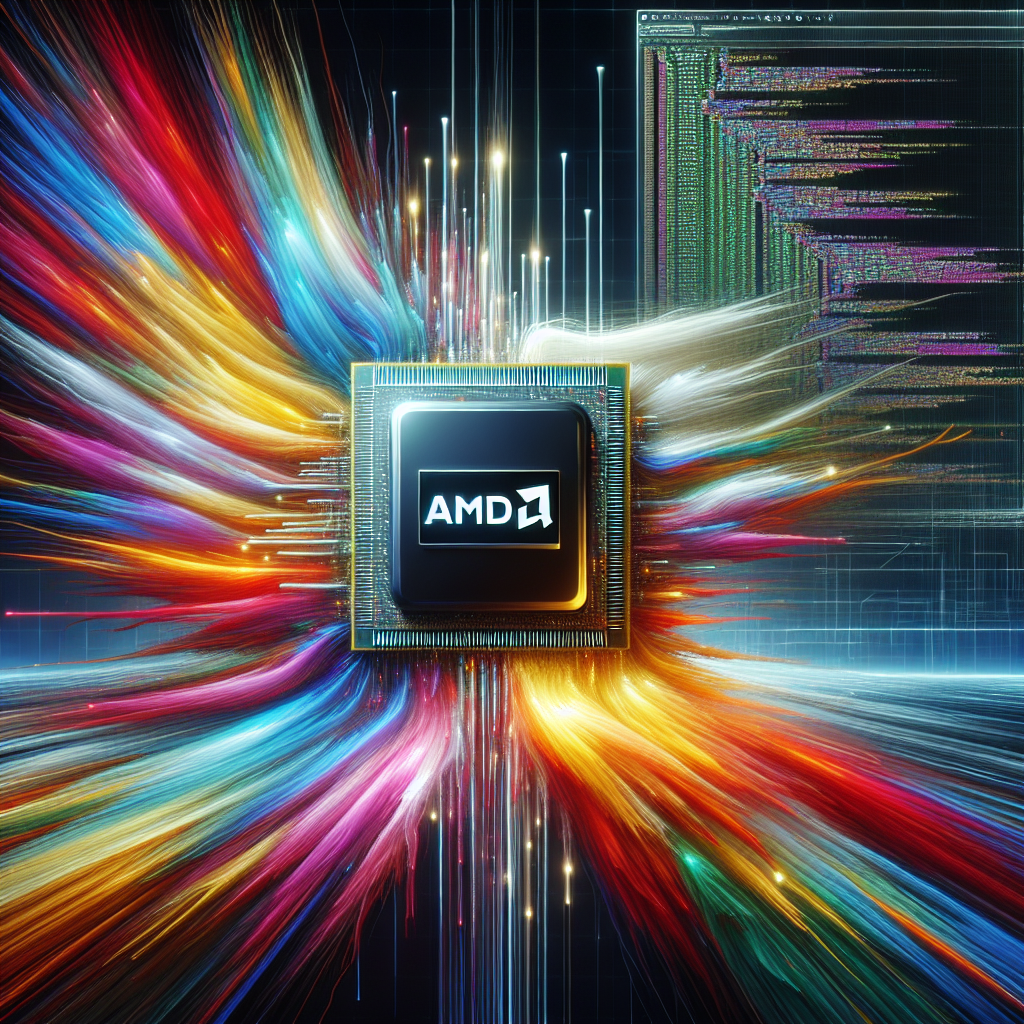AMD’s FidelityFX Super Resolution 3 Release
AMD has made a significant announcement regarding the release of its FidelityFX Super Resolution 3 (FSR 3) development kit. This advanced suite of upscaling and frame generation tools is now available on GPUOpen and GitHub, providing public access to the technology. Launched almost nine months ago, FSR 3 is now open for developers to explore, experiment with, and integrate into their games and applications.
The release of FSR 3 into the wild marks a pivotal moment for game development, as it allows for a broader implementation of AMD’s cutting-edge technology. With the source code now in the hands of developers, the potential for innovation in game graphics and performance is substantial.

(Image credit: AMD)
FSR 3 in 2023 Game Releases
The adoption of AMD’s FSR 3 in 2023’s game releases has been notably limited. Despite the technology’s potential to revolutionize gaming graphics, only a handful of titles have incorporated FSR 3 thus far. The list of games that have embraced this advanced technology includes:
- Forspoken
- Immortals of Aveum
- Avatar: Frontiers of Pandora
While these games represent the early adopters of FSR 3, many other games continue to utilize previous iterations of AMD’s FidelityFX Super Resolution systems. For instance, FSR 2.2 has been implemented into the popular title Baldur’s Gate 3, showcasing the ongoing relevance of AMD’s earlier technologies in enhancing game performance and visual fidelity.
Understanding FSR 3 Components
The FidelityFX Super Resolution 3 (FSR 3) package is a comprehensive suite that includes four key systems: an upscaler, an optical flow technique, a frame interpolator, and a swapchain management routine. Each component plays a crucial role in enhancing the visual performance of games.
The upscaler is perhaps the most familiar element to many, utilizing a series of sophisticated algorithms processed through shaders to boost the resolution of a frame while refining the overall image quality. This has been a core feature of FSR since its inception.
However, the introduction of frame generation with FSR 3 marks a significant advancement. This feature was developed by AMD as a direct competitor to Nvidia’s DLSS 3 Frame Generation, which employs a machine learning model to generate a new frame from two previously rendered frames. Unlike Nvidia’s proprietary system, which is limited to its GeForce RTX 40-series graphics cards, FSR 3 boasts wide compatibility, functioning on any GPU that supports DirectX 12 and compute shaders v6.2.
Moreover, the open-source nature of FSR 3 is a game-changer, offering developers the freedom to modify and integrate the technology into their software without restrictions. This level of accessibility is unprecedented in the realm of advanced gaming technologies.

(Image credit: AMD)
Community Reception and Modding Potential
The modding community has warmly received AMD’s announcement of the FidelityFX Super Resolution 3 (FSR 3) development kit. There is a palpable sense of anticipation for the emergence of FSR 3 frame generation mods, which could potentially enhance games that currently lack this feature.
Despite the excitement, modders are likely to encounter technical hurdles, especially when dealing with frame interpolation and the management of user interfaces (UI) in games. The frame interpolation algorithm of FSR 3 necessitates the presence of the upscaler from FSR 2, and additional data buffers are required for the various components of FSR 3 to communicate effectively.
Managing the UI during the rendering process presents its own set of challenges. For FSR 3 frame interpolation to function correctly, the UI must be rendered in a specific manner. It should either be a separate function called upon the completion of each frame, rendered as a texture applied at the end, or the game engine must render frames without the UI for the interpolation step.
Many games opt for the second method, creating the UI with each real frame, which could result in the UI appearing glitchy or laggy on generated frames. Overriding a game’s UI creation and management is not a trivial task, and it’s expected that many FSR 3 frame generation mods will face image quality issues.
Nevertheless, the modding community is known for its creativity and resourcefulness. Given the open-source nature of FSR 3, there is optimism that modders will devise innovative solutions to circumvent these challenges.
The Future of FSR 3
The potential for FidelityFX Super Resolution 3 (FSR 3) to be more widely adopted in future games is significant. Community discussions and rumors suggest that developers are considering the inclusion of FSR 3 in upcoming titles. For instance, there has been speculation that FSR 3 might be integrated into the next installment of the Call of Duty series, which has historically performed well on AMD GPUs.
For developers, the benefits of implementing FSR 3 are clear. It offers a way to enhance game performance and visual quality without being tied to proprietary hardware. The technology’s compatibility with DirectX 12 is already established, and support for Vulkan is currently in development, although no release date has been provided.
The open-source nature of FSR 3 not only fosters innovation but also encourages a collaborative approach to game development. As the technology becomes more accessible, it’s likely that we will see it featured in a broader range of games, from indie projects to major AAA titles.
Conclusion
The introduction of AMD’s FidelityFX Super Resolution 3 (FSR 3) marks a significant milestone in gaming technology. With its open-source availability and compatibility with a wide range of GPUs, FSR 3 has the potential to greatly impact the quality and performance of future games. As developers and modders alike begin to explore and implement this technology, we may witness a new era of visual fidelity in gaming.
However, it’s important for enthusiasts and gamers to manage their expectations regarding the quality of mods. While modders are known for their ingenuity, the complexity of integrating advanced features like frame generation can lead to varying results. The community’s creativity will be key in overcoming technical challenges and ensuring that FSR 3 reaches its full potential.
In the end, the role of modders cannot be understated in the adoption and evolution of FSR 3. Their contributions may not only enhance existing games but also inspire developers to natively incorporate these advancements in future releases.

